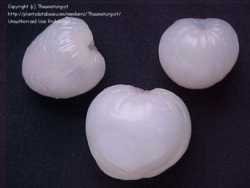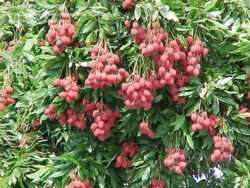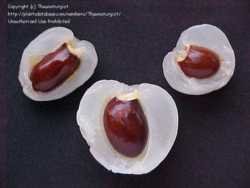





Growing up in south Florida, we often ate dinner at Chinese restaurants where we would sometimes be served a dessert that was a white, almost gelatinous blob called a Lychee, presented in a clear syrup. I was not impressed. Then as a young adult I was invited to dinner with a couple who served fresh lychees from their own trees and I was hooked!
 Lychees are small, round fruits slightly larger than a golf ball, with a dark pinkish skin that is thin but rough and easily removed. The fruit inside is a sweet white translucent flesh surrounding a large seed that reminds me of a buckeye. Although not poisonous, the seed should not be eaten. The texture of the fruit is somewhat like a melon or a grape, and high in vitamin C.
Lychees are small, round fruits slightly larger than a golf ball, with a dark pinkish skin that is thin but rough and easily removed. The fruit inside is a sweet white translucent flesh surrounding a large seed that reminds me of a buckeye. Although not poisonous, the seed should not be eaten. The texture of the fruit is somewhat like a melon or a grape, and high in vitamin C.
Lychees have a shelf life of 3-5 days at room temperatures. Because of their short shelf life, lychees are usually seeded and canned in a sweet syrup, or dried. They dry naturally if hung in clusters in a closed, air-conditioned room. The flesh turns dark and wrinkly like a raisin. Lychees can be pickled or spiced, made into preserves and jelly, and cooked into a sweet sauce. There is a little known lychee wine, too.
In China, honey is harvested from hives near the lychee trees. The high quality lychee honey from bee colonies in south Florida is a rich, light amber with the delicious taste of the lychee juice like you get from from peeling the fruit. The lychee honey does not granulate.[1] Lychee trees are spectacular in spring with their enormous sprays of tiny yellowish flowers  that grow in clusters.
that grow in clusters.
The Lychee (Litchi chinensis) is the sole member of the genus Litchi, in the Soapberry family Sapindaceae. It is a tropical fruit generally found in China, India, the Phillipines, Indonesia and now grown commercially in south Florida and southern California. The trees grow to 30-40 feet in full sun and are only hardy in USDA Zones 9b-11. They like a mildly acidic soil (pH 6-7) and will not tolerate standing water. However, the Chinese often plant lychees on the banks of ponds and streams.[2] Propagation is best by air layering as attempts to grow lychees from cuttings has not been very successful.
Medicinal Uses
“Ingested in moderate amounts, the lychee is said to relieve coughing and to have a beneficial effect on gastralgia, tumors and enlargements of the glands.
In China, the seeds are credited with an analgesic action and they are given in neuralgia and orchitis. A tea of the fruit peel is taken to overcome smallpox eruptions and diarrhea. In India, the seeds are powdered and, because of their astringency, administered in intestinal troubles, and they have the reputation there, as in China, of relieving neuralgic pains. Decoctions of the root, bark and flowers are gargled to alleviate ailments of the throat. Lychee roots have shown activity against one type of tumor in experimental animals in the United States Department of Agriculture/National Cancer Institute Cancer Chemotherapy Screening Program.”[3]
Some Cultivars
Amboina Medium, bright red, borne in clusters of 6 to 20. Ripens April to May. Slow-growing tree. Bears regularly in warm climates.
Bengal Introduced by USDA in 1929 from Calcutta. Fruits are similar to Brewster but more elongated with smaller seeds. Firm flesh. Dry and clean type. Large, very vigorous tree. Easy to grow.
Brewster Large, conical or wedge-shaped red fruit with soft flesh. Slightly acid with fully formed large seeds. Commercial crop in Florida. Mid-season fruiting. Large, vigorous, upright tree.
Fei tsu hsiao The Concubine Smiles, large, amber-colored, thin-skinned, with very sweet, very fragrant flesh
Groff Small, dull red, spiny, borne in clusters of 20 to 40. Small seed. Ripens August to September. Latest ripening variety. Upright tree.
Hak ip Medium-red fruit sometimes with green tinges with soft skin. Flesh is crisp sweet and occasionally pinkish.
Kwa luk (Hanging Green), The most famous (and most rare) lychee in existence. Large, red fruit with green tip and typical green line. Exceptional flavor and fragrance. In the past was a fruit given to person of honor. Dry and clean type.
Hsiang li (fragrant lychee), fruit is small, very rough and prickly, deep-red, with the smallest seeds of all, and the flesh is of superior flavor and fragrance.
Hsi Chio tsu (rhinoceros horn), fruit is large, rough, broad at the base and narrow at the apex; has somewhat tough and fibrous, but fragrant, sweet, flesh. It ripens early.
Mauritius (Kwai Mi) Ripens early. Medium size, slightly oval, reddish-brown fruit. Firm, good-quality fruit. Tends to have chicken-tongue seeds.
No Mai Tsze (Glutinous Rice Ball) Large, red, dry and clean type. Leading variety in China. Small seeds. One of the best for drying.
T' ang po' (pond embankment), fruit is small, red, rough, with thin, juicy acid flesh
Tai tsao Fruit ripens early. Somewhat egg-shaped, bright red, rough skin. Crisp, sweet, firm flesh. Leaks juice when skin is broken.
Some Sources for Lychee Plants
River's End Nursery
Top Tropicals
Lychees Online
Nipa Hut Gardens
Miami Craig's List
Footnotes
[1] http://www.hort.purdue.edu/newcrop/morton/lychee.html
[2] http://www.riversendnursery.com/home.asp
[3] Morton, J. 1987. Lychee. p. 249–259, Fruits of Warm Climates, Julia F. Morton, Miami, FL.
Photo Credits: Thanks to Thaumaturgist and Dave for their photos in the Plantfiles.
Lychee Salsa
2 cans lychees, pitted and peeled (available at oriental grocers, or online)
1⁄4 cup diced red pepper
1 Tbsp. minced green onion
1 Tbsp. minced fresh cilantro
1 Tbsp. fresh-squeezed lime juice
3 tsp. olive oil
Pinch of crushed red pepper
Salt and pepper to taste
1⁄2 jalepeño pepper, minced
With a large knife, dice canned fruit into 1⁄4 inch pieces. Combine with red pepper,
green onion, cilantro, lime juice, olive oil, crushed red pepper,
salt, pepper and jalepeño.
Cover tightly and refrigerate at least 3 hours, or overnight.
Makes 21⁄2 cups
Stuffed Lychees
(Makes about 4 dozen)
2 cans (1 lb, 4 oz size) pitted lychees (from any oriental grocer or online)
1 pkg (8 oz) cream cheese
1 tablespoon sherry
Dash salt
3 tablespoons chopped macadamia nuts
2 tablespoons chopped crystalized ginger
Drain lychees. In small bowl of electric mixer, beat cream cheese with sherry and salt
until mixture is smooth. Stir in remaining ingredients. Stuff lychees and chill until serving.
Copyright © www.100flowers.win Botanic Garden All Rights Reserved